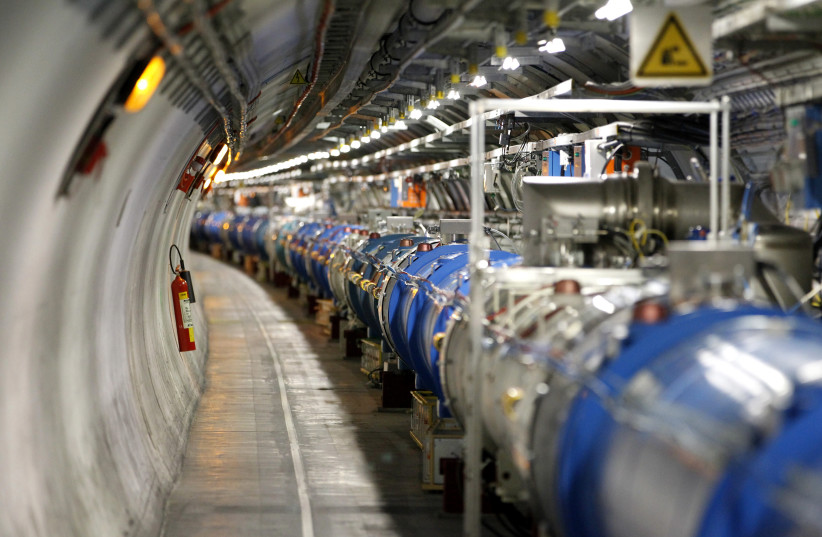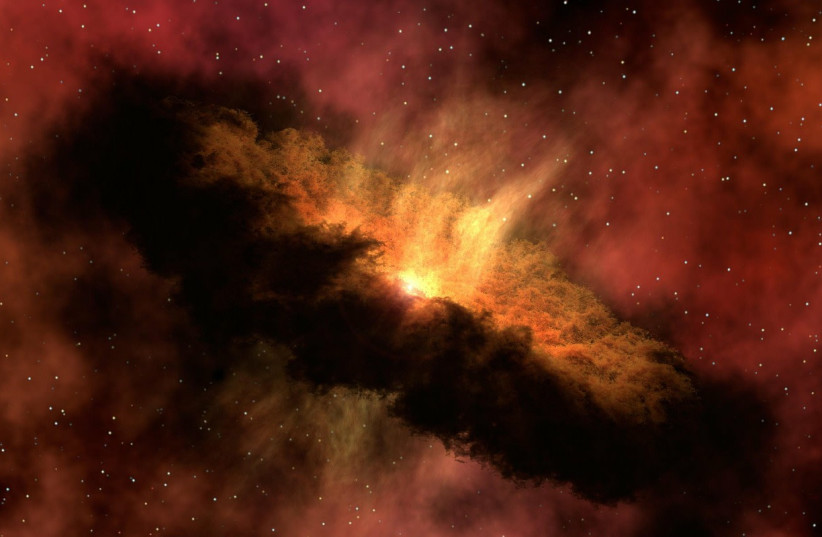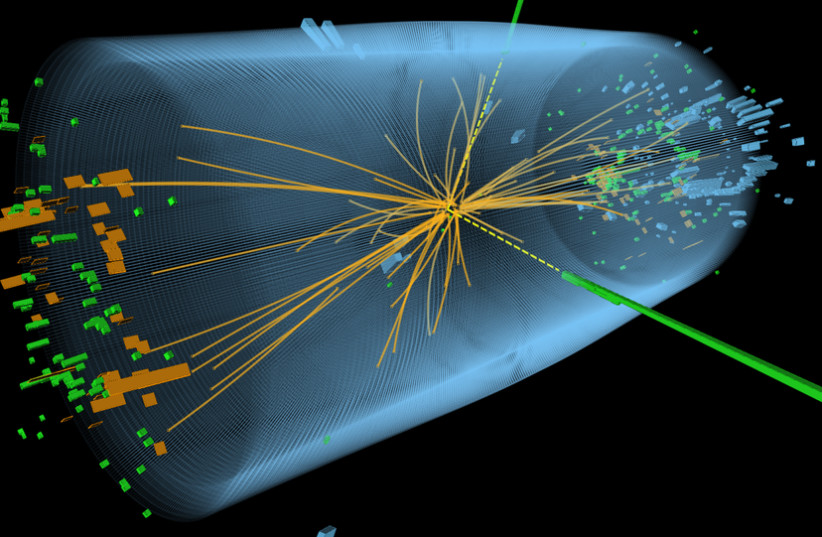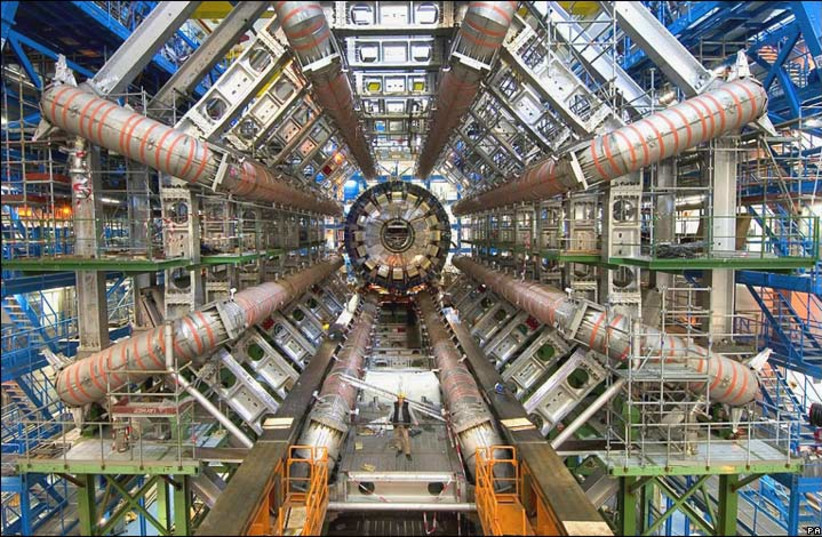GENEVA – In boxing, a fighter is said to punch above his weight if he hits as hard as boxers much heavier.
In high-energy physics – Big Science studying tiny sub-atomic particles – that phrase fits Israel to a “T,” a country that punches way above its weight in science and technology.
Specifically, Israel is the only non-European full member of CERN – a French acronym for Conseil européen pour la recherche nucléaire – the consortium of countries that built and run the amazing Large Hadron Collider (LHC).
Israeli researchers from Technion, Tel Aviv University and the Weizmann Institute play important roles in CERN research. And this has been the case for over 30 years.
I was privileged to visit CERN and to view the LHC here firsthand, after speaking to a conference of European R&D managers.

But first, some background.
<br>What is high-energy physics, also called particle physics?
It is a costly, lengthy, difficult quest to understand the very basic small stuff we are all made of.
Matter and radiation are made up of very small particles, much smaller than atoms or even protons. High energy physics studies the irreducibly smallest detectable particles and how they interact, in theory and through experiments.
The dominant theory that explains the dynamics of basic particles is called the Standard Model. Recent research suggests, as often happens with theory, that this model needs some repair.
For instance, consider ‘dark matter’ – dark, because we cannot see it, as it does not interact with light. Astronomers say there must be nearly six times more matter in the universe than we can now see, to explain galaxies and how they form and behave.
And ‘dark energy.’ We now know the universe is expanding at an accelerating rate. But how? Why does gravity not slow it down?
There must be unknown, unobserved energy out there, fully two-thirds of all energy currently known, that drives this ever-more-rapid expansion and overcomes the pull of gravity.

How do scientists study the tiny particles that we are all made of?
With massive accelerators like LHC, located in a suburb of Geneva, at the Swiss-French border.
Picture a huge circular racetrack, 27 km. (17 miles) in circumference, in a tunnel deep underground. Except it is not for Formula 1 race cars (200 mph) or Arabian thoroughbred horses (44 mph). Rather, it is a racetrack for protons. And the protons do not race in parallel, but purposely smash into one another from opposite directions, at very close to 186,000 miles per second, nature’s speed limit.
Inside the accelerator, two high-energy particle beams of protons travel at close to the speed of light, but in opposite directions, before they are made to collide. Super-powerful magnets speed them up. When they smash into one another, a whole array of smaller particles are generated.
Why do this? The tiny particles flying off these violent proton collisions can reveal what is inside them. It takes great ingenuity to observe the particles emerging from these collisions – and as we shall see below, Israeli physicists play a key role in this.
Protons have a positive charge. Huge superconducting electromagnets can accelerate the protons and then make them collide. And believe me: it is a lot harder to do this than to describe it. It takes immense creativity and engineering skill and massive resources to get two proteins, each one-millionth of a nanometer in size, to smash head-on into one another when each is traveling at nearly the speed of light. It is not unlike having two tiny bumblebees fly in opposite directions around the earth and then smash into one another precisely at Times Square.
<br>How have Israeli physicists specifically contributed to high-energy physics research?
I spoke with Yoram Rozen, Technion physics professor, who explained it in laymen’s terms:
“The High Energy Physics group at the Technion, with Profs. Enrique Kajamovitz, Shlomit Tarem and myself, is active at CERN, the European center for particle physics. Israel became the first non-European member in 2014.
“The group is mainly involved in an experiment called ATLAS at the Large Hadron Collider. The goal of the collider and the ATLAS detector is to investigate, discover and understand the fundamental laws of physics that govern the universe.
"The goal of the collider and the ATLAS detector is to investigate, discover and understand the fundamental laws of physics that govern the universe."
Yoram Rozen
“The current knowledge is summarized in a theory called the Standard Model. The last piece of this puzzle was discovered by the ATLAS and CMS collaborations [Compact Muon Solenoid, a general-purpose detector] in July 2012. This is of course the Higgs boson, whimsically called the God Particle. The Technion group contributed to the search for the Higgs particle, which in 2013 won Peter Higgs and François Englert the Nobel Prize in Physics.”
<br>Wait a minute! God Particle? What in the world?
In science, scholars build theories and then experimenters try to prove or disprove them. A physicist named Peter Higgs theorized in 1964, with several others, that a “scalar boson” (later known by his name) should exist. But proving its existence, crucially important, turned out to be really hard. It took 48 years.
In 2012 experiments at the CERN, LHC finally found a subatomic particle that matched the elusive Higgs boson.

But why was it called the God Particle?
According to Business Insider: “The phrase God Particle was plastered across the front pages of news outlets everywhere when the discovery of the particle was announced in 2012. “God Particle Discovered” is a much sexier headline than “Higgs boson discovered,” but most physicists hate the term.
“It was not the intended nickname for the famous particle. The story goes that Nobel Prize-winning physicist Leon Lederman referred to the Higgs as the Goddamn Particle, meant to poke fun at how difficult it was to detect the particle. It took nearly half a century and a multi-billion-dollar particle accelerator to do it.
“The Goddamn Particle was the title of Lederman’s book that came out in the 1990s and was wildly popular. However, his publishers weren’t exactly on board with that phrasing, so the title was changed instead to the God Particle.”
I think God Particle is a perfect name for the tiny Higgs boson, and here is why. A CERN official explained that the discovery of the God Particle helps explain what happened one-trillionth of a second after the Big Bang, the massive explosion that created our universe 13.8 billion years ago.
But the CERN physicists are not satisfied. They seek to look back in time to 10 to the minus 43rd seconds after the Big Bang.
How will this end poverty, cure cancer, wipe out hunger, halt wars and lengthen life? It won’t. But mankind has always sought to understand the origins of the universe. It is a worthy quest of great intrinsic value.
Rozen continues to describe the LHC and Israel’s role:
“We already know that the Standard Model is not the final word in describing the universe. There is evidence that suggests that there is more to it, that it is a limited version of a larger theory. While we do not know what this additional physics is, often called physics beyond the Standard Model, we have a powerful tool at our hands to investigate the possibilities.
“This tool is the LHC and the ATLAS detector. The LHC, a 27 km. instrument-cluttered tunnel, accelerates protons (hydrogen nuclei) to an incredible energy, bringing them to 99.9999% of the speed of light, the ultimate speed limit of the universe. When these protons collide, they can create heavy particles via the famous Einstein formula E=Mc2. Heavy unstable particles decay into lighter ones and eventually into stable particles following the laws of nature. Measuring the final particles in the chain is the way to trace back and learn about these laws.
“The particles are measured by the ATLAS detector, a large building-size apparatus. Three universities in Israel – Technion, Weizmann Institute and Tel Aviv University – collaborated to build a significant piece of the ATLAS detector, capable of detecting and identifying a particle called a muon whose presence in the collision might hint at an interesting process worth studying.
“In addition to the contribution to the construction and operation of the detector, the Technion group is very active in the search for the improved standard model. To be more specific, we are active in searches for additional Higgs particles, not the standard model particle but a new one that is charged. We are exploring other avenues as well, exploiting our deep knowledge of the muon system and looking for particles that in contradiction to the standard model binds differently to muons.
“Last but not least, we look for Dark Matter by searching for anomalies in the behavior of collision events where some energy seems to be missing. There are several observations in astronomy that tell us that the amount of matter seen is significantly less than what is needed to explain the behavior of celestial objects. Not being able to see this extra matter means it does not bind to light, hence it was named Dark Matter.”

How did Israel get to sit at this phenomenal CERN table and in many ways play a leading role?
Israeli physicists have always excelled at high-energy physics theory and experiments. Hence Israeli scientists were involved with CERN research as early as 1991. And on January 15, 2014, Israel joined the 20 other CERN member states as an official full-fledged member. Members fund CERN in proportion to their GDPs; Israel pays for close to 2% of the CERN budget. I understood that Palestinians also do research at CERN, which Israelis foster. Politics are absent. Scientists from nations that dislike one another collaborate closely at CERN.
<br>How has humanity benefited from this expensive research?
A senior CERN official explained that when CERN was born, in 1954, two primary goals were, first, to stem the brain drain of young European scientists leaving for the US, and second, to establish a cooperative framework among European nations that had earlier fought two terrible wars.
It emerges that finding the “God Particle” was just the start. There may be a whole family of Higgs boson particles. In science, as in life, one thing leads to another. Look for CERN, and Israeli physicists who join in its research, to continue to unlock the deepest mysteries of our existence.
There are 9,000 workers and scientists on the site daily, and a total of 70 km. (43 miles) of tunnels and caverns, with 670 buildings. The Large Hadron Collider alone took a decade to construct, at a cost of $4.75 billion. According to Forbes magazine, “taking all costs into consideration, the total cost of finding the Higgs boson ran about $13.25 billion.”
For me, a Masorti Jew, visiting CERN was a religious experience. At the place where the God Particle was discovered, I wondered, is there sacrilege in the very name? Not in the least.
The more we understand the amazing complexity and astounding order of our universe and what it is made of, the more I personally find it a believable hypothesis that it is of Divine origin.
“And I [God] shall dwell within you,” the Bible says. At CERN, for me, “within” took on new meaning. ■
The writer heads the Zvi Griliches Research Data Center at S. Neaman Institute, Technion, and blogs at www.timnovate.wordpress.com
